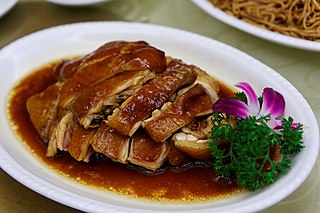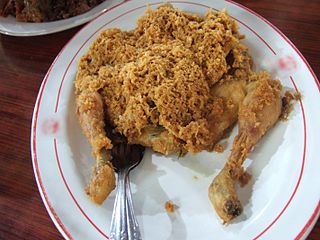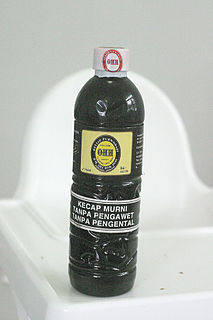
Soy sauce chicken is a traditional Cantonese cuisine dish made of chicken cooked with soy sauce. It is considered as a siu mei dish in Hong Kong.

Chinese Indonesian cuisine is characterized by the mixture of Chinese with local Indonesian style. Chinese Indonesians, mostly descendant from Hokkien, brought their legacy of Chinese cuisine, and modified some of the dishes with the addition of Indonesian ingredients, such as kecap manis, palm sugar, peanut sauce, chili, santan and local spices to form a hybrid Chinese-Indonesian cuisine. Some of the dishes and cakes share the same style as in Malaysia and Singapore which are known as the Nonya cuisine by the Peranakan.

Javanese cuisine is the cuisine of Javanese people, a major ethnic group in Indonesia, more precisely the province of Central Java, Yogyakarta and East Java. Though the cuisine of Sumatra is known for its spiciness with notable Indian and Arabic influences, Javanese cuisine is more indigenously developed and noted for its simplicity. Some of Javanese dishes demonstrate foreign influences, most notably Chinese.

Nasi bogana or nasi begana, pronounced as nah-see boh-gâna, is an Indonesian style rice dish, originally from Tegal, Central Java. It is usually wrapped in banana leaves and served with side dishes.

Soto mie, Soto mi, or Mee soto is a spicy Indonesian noodle soup dish commonly found in Indonesia, Malaysia, and Singapore. Mie means noodle made of flour, salt and egg, while soto refers to Indonesian soup. In Indonesia it is called soto mie and is considered as one variant of soto, while in Malaysia and Singapore it is called mee soto.

Kwetiau goreng is a Chinese Indonesian stir fried flat rice noodle dish from Indonesia and popular in Southeast Asia. This flavorful and spicy fried noodle dish is common in Indonesia. It is made from noodles, locally known as kwetiau, which are stir fried in cooking oil with garlic, onion or shallots, beef, chicken, fried prawn, crab or sliced bakso (meatballs), chili, Chinese cabbage, cabbages, tomatoes, egg, and other vegetables with an ample amount of kecap manis. In Asia, kwetiau is available in two forms, dried and fresh. Its recipe is quite similar to another Chinese Indonesian favourite, mie goreng, with the exception of replacing yellow wheat noodles for flat rice noodles.

Mie ayam, mi ayam or bakmi ayam is a common Indonesian dish of seasoned yellow wheat noodles topped with diced chicken meat (ayam). It especially common in Indonesia, Singapore and Malaysia, and can trace its origin to Chinese cuisine. In Indonesia, the dish is recognized as a popular Chinese Indonesian dish, served from simple travelling vendor carts frequenting residential areas, humble street-side warung to restaurants.

Bubur ayam is a Chinese Indonesian chicken congee. It is rice congee with shredded chicken meat served with some condiments, such as chopped scallion, crispy fried shallot, celery, tongcay, fried soybean, Chinese crullers, and both salty and sweet soy sauce, and sometimes topped with yellow chicken broth and kerupuk. Unlike many other Indonesian dishes, it is not spicy; sambal or chili paste is served separately. It is a favourite breakfast food, served by humble travelling vendors, warung, fast food establishments, and five-star hotel restaurants. Travelling bubur ayam vendors frequently pass through residential streets in the morning selling the dish.

Mie koclok, is an Indonesian chicken noodle soup, a specialty of Cirebon city, West Java. The noodles come with a white-colored extra-thick porridge-like soup, made of chicken broth and coconut milk soup, which is coagulated with corn starch or tapioca. Other ingredients include shredded chicken breast, cabbage, bean sprouts, hard boiled egg, kaffir lime juice, and sprinkled with sliced fresh celery, spring onion, and fried shallot.

Mie kangkung, is an Indonesian vegetable noodle soup with kangkung, usually served with bakso meatball and mushroom. It is of a specialty of Betawi cuisine, Jakarta, Indonesia. The yellow egg noodles come with a brown-colored thick soup, made of chicken or beef broth, which is thickened with tapioca, spiced and mixed with garlic and kecap manis. Other ingredients include bakso meatballs, bean sprouts, mushroom, hard boiled quail eggs and sprinkled with bawang goreng and added with dash of kaffir lime juice and sambal.

Ayam goreng is an Indonesian and Malaysian dish consisting of chicken deep fried in oil. Ayam goreng literally means "fried chicken" in Malay and also in many Indonesian regional languages. Unlike the Southern United States-style fried chicken, this Southeast Asian version is neither coated in batter nor flour, but rather seasoned rich in various spices.

Ayam bakar is an Indonesian and Malaysian dish, consisting of charcoal-grilled chicken. Ayam bakar literally means "roasted chicken" in Indonesian and Malay.

Soto is a traditional Indonesian soup mainly composed of broth, meat, and vegetables. Many traditional soups are called soto, whereas foreign and Western influenced soups are called sop.

Sweet soy sauce is a sweetened aromatic soy sauce, originating in Indonesia, which has a darker color, a viscous syrupy consistency and a molasses-like flavor due to the generous addition of palm sugar. Kecap manis is widely used with satay. It is similar to, though finer in flavor than, Chinese sweet bean sauce (tianmianjiang). It is by far the most popular type of soy sauce employed in Indonesian cuisine, and accounts for an estimated 90 percent of the nation's total soy sauce production.

Ayam kecap or ayam masak kicap is an Indonesian chicken dish poached or simmered in sweet soy sauce commonly found in Indonesia and Malaysia.

Babi kecap is an Indonesian braised pork with sweet soy sauce. It is a Chinese Indonesian classic, due to its simplicity and popularity among Chinese Indonesian households. It is also popular among non-Muslim Indonesians, such as the Balinese, Batak and Minahasan, and in the Netherlands, where it is known as babi ketjap, owing to colonial ties with Indonesia. In the Netherlands, the dish might also be served within an opulent rijsttafel banquet.

Ayam bumbu rujak is a typical Javanese food made from chicken meat which is still young and uses a red basic spice then grilled. A red base is a spice made from salt, garlic, onion, and red chili. Called seasoning rujak because there are many spices besides chili, including brown sugar which is commonly used in fruit rojak sauce. Ayam bumbu rujak often called ayam bakar bumbu rujak since it is grilled, thus often regarded as one variant of various ayam bakar recipes.

Bawang goreng is an Indonesian crispy fried shallots condiment, a popular garnishing to be sprinkled upon various dishes of Indonesian cuisine. It is quite similar to crisp fried onion.
















